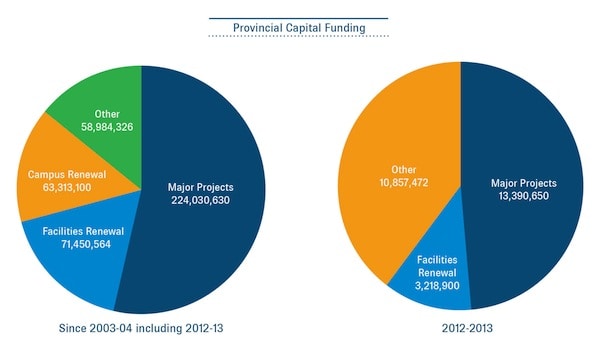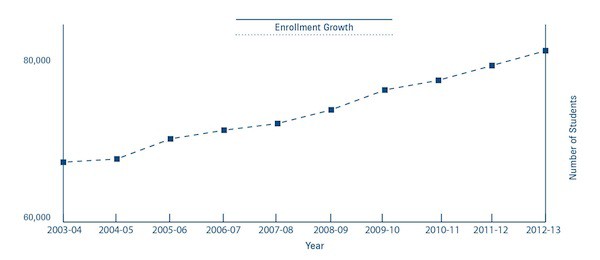The parking lot on St. George Street behind Convocation Hall will soon be covered in scaffolding, with work on the Faculty of Applied Sciences and Engineering’s Centre for Engineering Innovation and Entrepreneurship (CEIE) scheduled to be completed in late 2016.
U of T’s $2 billion Boundless campaign aims to fund a large number of new buildings and capital projects, including building the Centre for Engineering Innovation and Entrepreneurship, the expansion and renovation of the Faculty of Law, and the renovation of the north building at UTM. Some university figures, however, have suggested that the way the university tries to attract donor contributions and provincial funding structures for capital projects incentivize building new over maintaining the infrastructure the university already has. This could be problematic, as buildings in need of repair go ignored while funds are diverted to new construction.
The Engineering Society (EngSoc) has contributed $1 million towards the costs of the building. Rishi Maharaj, former president of EngSoc, says the money came from the Skule Endowment Fund, set up in 2010 to establish a permanent endowment for the society, with the aim of eventually replacing the society’s annual fee and the student contribution to the faculty’s operating maintenance budget. Engineering students contribute $100 a year to the fund. “One of the provisions was that the capital could potentially be spent for something major like a new building,” he explained.
Maharaj said that initial plans for the CEIE did not include any student space, and that EngSoc’s donation to the project, an initiative begun last year, is partly an attempt to remedy that situation. “What eventually emerged during my time, was that we would be much more likely to be able to get not all the things we wanted, but a substantial number of them, if we were willing to come up with some money. That was the genesis of the idea to give the university some money.”
Direct student contributions to capital projects like new buildings show a sense of ownership and an acknowledgement that students benefit from these projects, said David Palmer, U of T’s vice-president, advancement and the person behind Boundless. Palmer said that voluntary one-time donations — as opposed to the referendum-supported levy, used to partly fund the Goldring Student Centre at Victoria University, for example — are also a great motivating tool for donors. “That type of student giving is one of the most powerful incentives for donors and alumni to give,” he explained.
Build new or renovate?
Tamer El-Diraby, an associate professor in U of T’s Department of Civil Engineering, says that the university’s focus on new building is partly pragmatic. “There is no politician that I am aware of that wants to cut the ribbon for the renovation of a building instead of placing the foundation stone for a new building,” he said.
Many of the capital projects currently underway at the university include significant renovation or maintenance components, including the north building and 1 Spadina projects. Palmer says that donors do not express a preference for new buildings at the expense of renovating the university’s existing infrastructure. “I’ve never had a donor express to me a preference for new versus renovated [buildings],” he said. “In fact many of the biggest capital projects that we’ve had donors give money to are a combination of both.’
The provincial government has provided $417 million in capital funding to U of T since 2003, according to figures provided by the ministry of training, colleges, and universities (TCU) (see graph above). New buildings and construction accounted for $224 million of those funds. Universities need to consider the maintenance costs associated with new buildings when they apply for funding said Brad Duguid, minister of TCU. “[When] we invest in a new capital project for a university or college, the expectation is that the maintenance of that facility will be covered under the operating budgets of the institution,” he explained. “If an institution doesn’t have the capability of maintaining a facility, they ought to not be applying for funding for us to build it.”
Palmer admitted that donors often have a similar attitude. “Deferred maintenance is often seen by people as the responsibility of the system, of the university, to maintain things correctly,” he explained. “I have never had much success in going to a donor with a pitch to have their funds allocated towards deferred maintenance.” Last week, in responding to questions about deferred maintenance, the university administration indicated that it believes provincial funding levels are currently insufficient, and that it is lobbying the Ontario government on the matter.
Why are we expanding?
Duguid says new infrastructure is key to maintaining the reputation and ranking of Ontario’s universities. “There’s no question that the deferred maintenance issue is a pressure,” he admitted. “At the same time, we also have the pressure of ensuring that we’re continuing to provide a globally-competitive education experience to our students.”
Enrollment at the university has increased significantly in recent decades, with the total number of full-time students at U of T growing from 55,127 in 2000–2001 to 80,899 in 2012–2013. Michael Kurts, assistant vice-president of strategic communications and marketing, said in an email that “demand for PSE has increased due to population increases combined with increasing participation rates,” leading to a growth in enrollment.
These new students need new space, faculty and infrastructure. “U of T cannot say to students, ‘We will not have classrooms for you.’ We cannot say to a chair of a department, ‘We cannot have a secretary for you.’ We cannot tell students, ‘We will not have professors to teach you,’” said El-Diraby. The result, he said, is that maintenance gets deferred because it is the only cost that can be delayed.
Palmer emphasized that the Boundless campaign reflects the priorities set by academic units within the university. “All the priorities for the campaigns begin with academic priorities, that are approved in academic plans by the divisions, and they have to be approved by the provost.”
The ability of a project to attract funding does play a significant role in the planning process, however. Maharaj said that during the initial planning stage for the CEIE, the faculty created a document detailing how the building’s space would be used, broken up into four or five blocks. “Each one of those blocks was based on some type of concept of some type of donor that they would be able to reach with the idea for that space.”
The university has repeatedly emphasized that donors do not try to interfere with the academic priorities or planning of faculties or departments. Brad Evoy, external commissioner of the University of Toronto Graduate Students’ Union (GSU), however, says that donor participation affects what the university is able to fund. “It’s much more about building a new program, building a new thing — something that seems cutting-edge,” he argued. “But it’s not so much about the bread-and-butter basics of the university.”
Palmer said attracting and retaining donors is dependent on their willingness to give to specific areas of the university’s need. “It is almost impossible to steer a donor to an area of interest where they have no interest,” he said. “It essentially is not sensible to even try, because donors — it’s their money, they can give it to whatever worthy charitable cause they wish, and there’s plenty of competition out there.”
What are the implications of this system?
The current system of donor contributions and government funding could lead to unforeseen problems in the future, according to Maharaj. “Over the long term you won’t have a master-planned university, you won’t have a university that evolves according to academic or educational goals — you’ll have a university that evolves towards what people are willing to pay for.”
The university’s Governing Council and Business Board approves capital projects, including new buildings and renovations. The Business Board meeting on Monday, November 4, will include the university advancement division’s quarterly report on gifts and pledges above $250,000.



